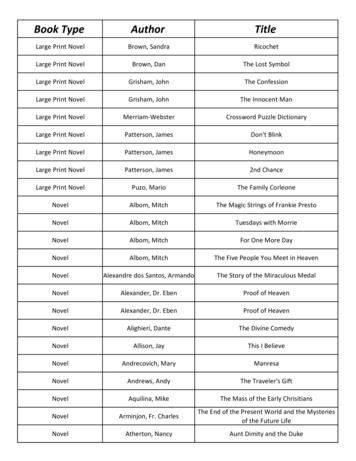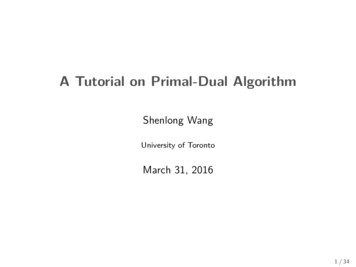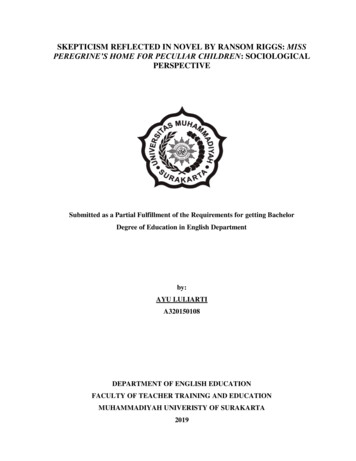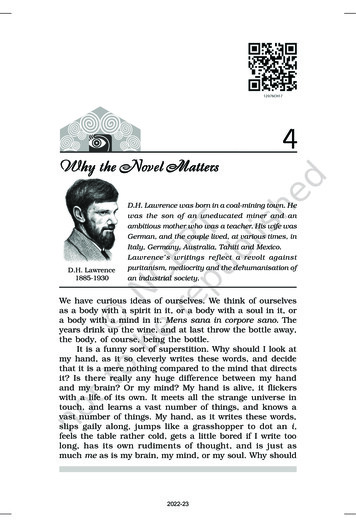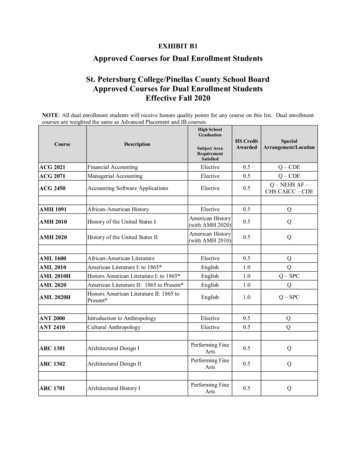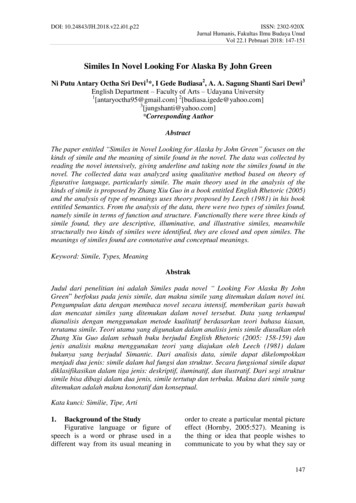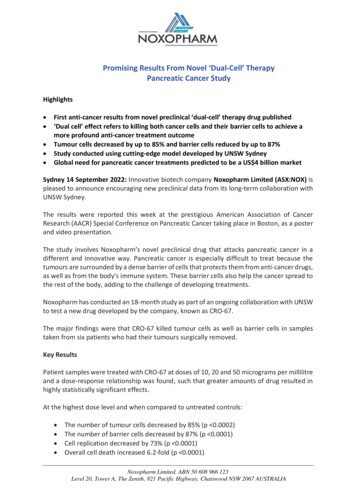
Transcription
Promising Results From Novel ‘Dual-Cell’ TherapyPancreatic Cancer StudyHighlights First anti-cancer results from novel preclinical ‘dual-cell’ therapy drug published‘Dual cell’ effect refers to killing both cancer cells and their barrier cells to achieve amore profound anti-cancer treatment outcomeTumour cells decreased by up to 85% and barrier cells reduced by up to 87%Study conducted using cutting-edge model developed by UNSW SydneyGlobal need for pancreatic cancer treatments predicted to be a US 4 billion marketSydney 14 September 2022: Innovative biotech company Noxopharm Limited (ASX:NOX) ispleased to announce encouraging new preclinical data from its long-term collaboration withUNSW Sydney.The results were reported this week at the prestigious American Association of CancerResearch (AACR) Special Conference on Pancreatic Cancer taking place in Boston, as a posterand video presentation.The study involves Noxopharm’s novel preclinical drug that attacks pancreatic cancer in adifferent and innovative way. Pancreatic cancer is especially difficult to treat because thetumours are surrounded by a dense barrier of cells that protects them from anti-cancer drugs,as well as from the body’s immune system. These barrier cells also help the cancer spread tothe rest of the body, adding to the challenge of developing treatments.Noxopharm has conducted an 18-month study as part of an ongoing collaboration with UNSWto test a new drug developed by the company, known as CRO-67.The major findings were that CRO-67 killed tumour cells as well as barrier cells in samplestaken from six patients who had their tumours surgically removed.Key ResultsPatient samples were treated with CRO-67 at doses of 10, 20 and 50 micrograms per millilitreand a dose-response relationship was found, such that greater amounts of drug resulted inhighly statistically significant effects.At the highest dose level and when compared to untreated controls: The number of tumour cells decreased by 85% (p 0.0002)The number of barrier cells decreased by 87% (p 0.0001)Cell replication decreased by 73% (p 0.0001)Overall cell death increased 6.2-fold (p 0.0001)Noxopharm Limited. ABN 50 608 966 123Level 20, Tower A, The Zenith, 821 Pacific Highway, Chatswood NSW 2067 AUSTRALIA
Further details can be found in the appendix to this announcement.Images: Fluorescence study showing living cells in blue and dead cells in greenImage 1 – A representative tumour sample with no treatment. There are high numbers of living cells (blue) in thecancer tissue sample after 12 days without treatment.Image 2 – A representative tumour sample with CRO-67 treatment. After 12 days of treatment with CRO-67 thereare predominantly dead cells (green) visible, and very few living cells (blue) remaining.This unique ability to target both cell types could pave the way for a novel treatment that isbeing termed ‘dual-cell’ therapy, to acknowledge the distinctive properties of the new drugand its innovative way of attacking pancreatic cancer.The study used a new cutting-edge model developed by UNSW that grows whole-tissuetumours and keeps pancreatic tumour cells as well as barrier cells alive in the laboratory forNoxopharm Limited. ABN 50 608 966 123Level 20, Tower A, The Zenith, 821 Pacific Highway, Chatswood NSW 2067 AUSTRALIA
12 days after they have been surgically removed from actual cancer patients. The tumourtissues were then treated with CRO-67 and studied under conditions as close as possible toreal life.There is an urgent need to develop more effective treatments for pancreatic cancer, which isset to become the second leading cause of cancer-related deaths in the US by 2030. It has afive-year survival rate of just 9% from the time of diagnosis.Professor Phoebe Phillips from UNSW said: “The results demonstrated CRO-67 has potentialto improve patient outcomes via a ‘dual-cell’ targeting activity that can attack tumour cellsdirectly while also destroying the tumour’s surrounding ‘helper cells’. Traditionalchemotherapeutics in this area have only targeted tumour cells and not the surroundinghelper cells, and therefore their treatment effect is very limited.”Noxopharm CEO Dr Gisela Mautner said: “The development of new treatments is a core partof our expanded drug development strategy, and we are pleased that the ChromaTM platformis showing such promising initial results. What makes this study so exciting is that it is theclosest you can get to studying human cancer in the laboratory before giving the drug topatients. It is still early days and there is a lot of work we need to do, but we are on an excitingpath. The market for pancreatic cancer drugs is sizeable and clearly underserved, whichpresents a valuable opportunity for Noxopharm.”The study will now be followed by more tests on the therapeutic efficacy of CRO-67, as wellas deeper analysis into the mechanisms by which CRO-67 exerts its ‘dual-cell’ targetingeffects. Several additional studies will need to be performed to support the research requiredto move CRO-67 towards clinical trials.In terms of commercial strategy, Noxopharm has filed comprehensive patent applications inorder to protect the value of its intellectual property in this area.The ChromaTM platform is one of two preclinical programs that support Noxopharm’s sciencedriven strategy to develop and progress the most promising life-saving therapies. The secondis the SofraTM technology platform that focuses on inflammation and autoimmune diseases.A timelapse video showing pancreatic cancer cells treated in vitro with CRO-67 is availablehere: https://youtu.be/6TbOixDq5McNoxopharm – UNSW AACR Abstract:Title: CRO-67 is a novel therapeutic for pancreatic cancer: implications for tumour andstromal reprogrammingAuthors: Kokkinos J1, Sharbeen G1, Haghighi KS2, Youkhana J1, Raina A1, Pitiyarachchi O1,Truong, Q3, Wenholz, D3,4, Laczka, O3, Kumar, N4, Goldstein D1,2, Phillips PA1.1PancreaticCancer Translational Research Group, School of Medical Sciences, Lowy CancerResearch Centre, UNSW Sydney.Noxopharm Limited. ABN 50 608 966 123Level 20, Tower A, The Zenith, 821 Pacific Highway, Chatswood NSW 2067 AUSTRALIA
2Princeof Wales Hospital, School of Clinical Medicine, Randwick Clinical Campus, UNSWSydney.3Noxopharm Limited, Sydney.4School of Chemistry, UNSW Sydney.-ENDSAbout NoxopharmNoxopharm Limited (ASX:NOX) is an innovative Australian biotech company discovering anddeveloping novel treatments for cancer and inflammation.It has three active drug development programs: its clinical-stage drug candidate Veyonda , plus twoinnovative technology platforms – ChromaTM (oncology) and SofraTM (inflammation andautoimmunity), which provide the basis for active development of a growing pipeline of newproprietary drugs.Noxopharm also has a major shareholding in the US biotech company Nyrada Inc (ASX:NYR), which isactive in the areas of drug development for cardiovascular and neurological diseases.To learn more, please visit: noxopharm.comInvestor, Corporate & Media enquiries:Julian ElliottM: 0425 840 071E: info@noxopharm.comCompany Secretary:David FranksT: 61 2 8072 1400E: David.Franks@automicgroup.com.auDr Gisela Mautner, CEO and Managing Director of Noxopharm, has approved the release of thisdocument to the market on behalf of the Board of Directors.Forward Looking StatementsThis announcement may contain forward-looking statements. You can identify these statements bythe fact they use words such as “aim”, “anticipate”, “assume”, “believe”, “continue”, “could”,“estimate”, “expect”, “intend”, “may”, “plan”, “predict”, “project”, “plan”, “should”, “target”, “will”or “would” or the negative of such terms or other similar expressions. Forward-looking statementsare based on estimates, projections and assumptions made by Noxopharm about circumstances andevents that have not yet taken place. Although Noxopharm believes the forward-looking statementsto be reasonable, they are not certain. Forward-looking statements involve known and unknownrisks, uncertainties and other factors that are in some cases beyond the Company’s control(including but not limited to the COVID-19 pandemic) that could cause the actual results,performance or achievements to differ materially from those expressed or implied by the forwardlooking statement.Noxopharm Limited. ABN 50 608 966 123Level 20, Tower A, The Zenith, 821 Pacific Highway, Chatswood NSW 2067 AUSTRALIA
FACT SHEETNoxopharm CRO-67Dual-Cell Therapy for Pancreatic CancerPancreatic CancerPancreatic cancer is highly aggressive with lowsurvival rates – only 9% of people survive five yearsafter diagnosisi. It is the 7th leading cause of cancerdeath worldwideii, more common in industrialisedcountries, and currently is the third leading cause ofcancer death in the United Statesiii.Despite an increased understanding of risk factorsand improvements in diagnosis, treatment optionsare still limited. As a consequence, the number ofpancreatic cancer cases is predicted to continueincreasing, with pancreatic cancer set to become the2nd leading cause of cancer related deaths in the USby 2030iv.Pancreatic cancer remains difficult totreat and has a low survival rateThe Challenge of Pancreatic CancerIn cancer, there are cells that are found in layers surrounding tumours known as CAFs (cancer-associatedfibroblasts). These CAFs create a barrier around the tumour, protecting it from treatment and promotingthe growth and spread of the tumour.A unique feature of pancreatic cancer is that the tumours are surrounded by a particularly dense barrier ofCAFs. It has only relatively recently been discovered that this barrier layer is why pancreatic cancer tendsto spread rapidly and is particularly difficult to treatv.With this new knowledge, Noxopharm has developed a ground-breaking dual-cell therapy approachto treating pancreatic cancer that focuses on attacking both the cancer cells and the CAFs forming thebarrier around the tumour with a single novel drug candidate – CRO-67.NOXOPHARM (ASX:NOX)DELIVERING SCIENCE. TRANSFORMING LIVES.
Noxopharm CRO-67The Noxopharm proprietary drug candidate CRO-67 has been generated from Noxopharm’s Chroma technology platform, which is focused primarily on developing oncology drug candidates.CRO-67 was selected from an extensive drug library and showed the most promising results in a numberof screening tests. It has been selected as the lead pancreatic cancer drug candidate due to its ability toact as a dual-cell therapy targeting both pancreatic tumour cells and the CAF (barrier) cells.The UNSW Sydney Pancreatic Cancer Explant ModelUNSW Sydney has developed a world-first explant model where tumours and the surrounding tissue(including the barrier formed by CAFs) are surgically removed from cancer patients. Details on the modelhave been published in the highly regarded journal Nature: Scientific Reportsvi.These samples are kept alive in the laboratory for 12 days where they continue to grow and behaveas they would inside the body. This cutting-edge technology is the first time that the dual-cell ability ofNoxopharm’s drug candidate CRO-67 can be tested for an extended period in a model that closelyreplicates how pancreatic cancer behaves in the patient. Using this model, it was possible to measure theactivity of CRO-67 against both the tumour and its surrounding barrier.ResultsPancreatic tumour samples werecollected from cancer patients, thenplaced in the UNSW model and treatedevery three days with CRO-67vii until Day12. Once the treatment was finished,the samples were analysed across fourparameters examining tumour and CAF(barrier) cell responses to CRO-67.BARRIER CELLSTUMOUR CELLSAll four parameters showed highlystatistically significant results: The number of tumour cells decreased The number of CAF (barrier) cells decreased Cell replication decreased Cell-death increasedCRO-67BARRIER CELL DEATHTUMOUR CELL DEATH
Representative tumoursample with no treatmentThere are high numbers of living cells(blue) in the cancer tissue sampleafter 12 days without treatment.Fluorescence study showing living cells in blue and dead cells in green.Representative tumoursample with CRO-67treatmentAfter 12 days treatment with CRO-67 thereare predominantly dead cells (green) andvery few living cells remaining.CRO-67 (μg/mL)Average % Reduction vs Barrier Cell Death54%2059%5073%CRO-67 (μg/mL)25Average % Increase vs Control10298%20313%50621%Percent of Live CAF (barrier) Cells vs UntreatedPercent of Live Tumour Cells vs Untreated1007550251020CRO-67 Concentration (μg/mL)Percent of Live CAF (barrier) Cells vs Untreated7587%10Total Cell Death0 0.000150Cell Replication1000.0002500.0018100Percent of Live Tumour Cells vs UntreatedTumour Cell Death 0.0001 0.000150 0.0001Table and graphs showingthe effect of increasingconcentrations of CRO-67p-valueon pancreatic tumour cell0.0123and CAF (barrier) cell0.0077numbers01020 after 12 days50 of 0.0001treatment.Thereisa clearCRO-67 Concentration (μg/mL)treatmenteffectwhereSignificance p 0.05higher concentrations ofCRO-67 resulted in lowercell numbers. 0.00011007550250102050CRO-67 Concentration (μg/mL)This world-first study demonstrates CRO-67 as a novel dual-cell therapy, potently75destroying both the tumour and its surrounding barrier. These highly promisingresults will now drive further studies to maximise the potential of this new approach to50pancreatic cancer treatment.25
REFERENCESi. Rawla P, Sunkara T, Gaduputi V. Epidemiology of Pancreatic Cancer: Global Trends, Etiology and Risk Factors.World J Oncol. 2019 Feb;10(1):10-27. doi: 10.14740/wjon1166. Epub 2019 Feb 26. PMID: 30834048; articles/PMC6396775/ii. Bray F, Ferlay J, Soerjomataram I, Siegel RL, Torre LA, Jemal A. Global cancer statistics 2018: GLOBOCAN estimates of incidence and mortality worldwide for 36 cancers in 185 countries. CA Cancer J Clin.2018;68(6):394–424. doi: /30207593/iii. Siegel, RL, Miller, KD, Fuchs, HE, Jemal, A. Cancer statistics, 2022. CA Cancer J Clin. 2022. 21708iv. Rahib L, Smith BD, Aizenberg R, Rosenzweig AB, Fleshman JM, Matrisian LM. Projecting cancer incidence anddeaths to 2030: the unexpected burden of thyroid, liver, and pancreas cancers in the United States. CancerRes. 2014 Jun 1;74(11):2913-21. doi: 10.1158/0008-5472.CAN-14-0155. Erratum in: Cancer Res. 2014 Jul15;74(14):4006. PMID: v. Neesse A, Michl P, Frese KK, Feig C, Cook N, Jacobetz MA, Lolkema MP, Buchholz M, Olive KP, Gress TM,Tuveson DA. Stromal biology and therapy in pancreatic cancer. Gut. 0966025/vi. Kokkinos J, Sharbeen G, Haghighi KS, Ignacio RMC, Kopecky C, Gonzales-Aloy E, Youkhana J, Timpson P, Pereira BA, Ritchie S, Pandzic E, Boyer C, Davis TP, Butler LM, Goldstein D, McCarroll JA, Phillips PA. Ex vivo cultureof intact human patient derived pancreatic tumour tissue. Sci Rep 11, 1944 ii. Kokkinos J, Sharbeen G, Haghighi KS, Youkhana J, Raina A, Pitiyarachchi O, Truong, Q, Wenholz, D, Laczka, O,Kumar, N, Goldstein D, Phillips PA. CRO-67 is a novel therapeutic for pancreatic cancer: implications for tumourand stromal reprogrammingFor more information, please contact Noxopharm:info@noxopharm.com 61 2 9144 2223Noxopharm LimitedLevel 20, Tower A, The Zenith821 Pacific HighwayCHATSWOOD NSW 2067noxopharm.com
ABN 50 608 966 123 Level 20, Tower A, The Zenith, 821 Pacific Highway, Chatswood NSW 2067 AUSTRALIA Promising Results From Novel 'Dual-Cell' Therapy Pancreatic Cancer Study . The results were reported this week at the prestigious American Association of Cancer Research (AACR) Special Conference on Pancreatic Cancer taking place in Boston .
